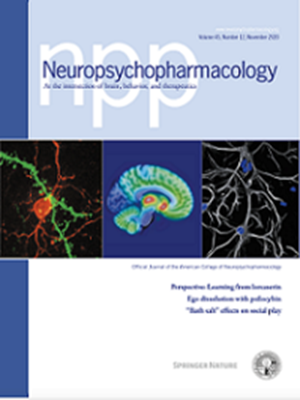Knockdown of USP22 alleviates LPS-induced microglial inflammation and mouse depressive-like behaviors via KAT2A
IF 6.6
1区 医学
Q1 NEUROSCIENCES
引用次数: 0
Abstract
Depression is a chronic mental illness that has emerged as the second most prevalent disease globally, characterized by symptoms such as low mood, reduced interest, and cognitive impairment. The onset of depression has been associated with microglial inflammation, but the molecular mechanisms behind this are not well understood. Here, we investigated the mechanisms involved in the roles of microglial inflammation in promoting depression by establishing a mouse model of inflammation-related depression via lipopolysaccharide (LPS) administration. We found that LPS treatment led to microglial activation and increased the deubiquitinating enzyme, USP22, expression in the mouse hippocampus. Further, knockdown of USP22 in microglia inhibited depressive-like behaviors and intracerebral inflammation in the mouse model. Moreover, subsequent mechanistic analyses revealed that KAT2A, which serves as a ubiquitination substrate, is modulated by USP22, thereby influencing mitochondrial damage and oxidative stress in microglia. Our findings indicate that USP22 facilitates oxidative stress and inflammatory responses in microglia through the deubiquitination of KAT2A, providing a promising target for the development of therapeutic strategy for the depression treatment.

敲低USP22可通过KAT2A减轻lps诱导的小胶质细胞炎症和小鼠抑郁样行为。
抑郁症是一种慢性精神疾病,已成为全球第二大流行疾病,其特征是情绪低落、兴趣减退和认知障碍。抑郁症的发病与小胶质细胞炎症有关,但其背后的分子机制尚不清楚。在这里,我们通过脂多糖(LPS)管理建立炎症相关性抑郁小鼠模型,研究了小胶质细胞炎症在促进抑郁中的作用机制。我们发现LPS处理导致小胶质细胞活化,增加小鼠海马中去泛素化酶USP22的表达。此外,在小鼠模型中,敲低小胶质细胞中的USP22可抑制抑郁样行为和脑内炎症。此外,随后的机制分析显示,作为泛素化底物的KAT2A被USP22调节,从而影响小胶质细胞的线粒体损伤和氧化应激。我们的研究结果表明,USP22通过KAT2A的去泛素化促进小胶质细胞的氧化应激和炎症反应,为抑郁症治疗策略的开发提供了一个有希望的靶点。
本文章由计算机程序翻译,如有差异,请以英文原文为准。
求助全文
约1分钟内获得全文
求助全文
来源期刊

Neuropsychopharmacology
医学-精神病学
CiteScore
15.00
自引率
2.60%
发文量
240
审稿时长
2 months
期刊介绍:
Neuropsychopharmacology is a reputable international scientific journal that serves as the official publication of the American College of Neuropsychopharmacology (ACNP). The journal's primary focus is on research that enhances our knowledge of the brain and behavior, with a particular emphasis on the molecular, cellular, physiological, and psychological aspects of substances that affect the central nervous system (CNS). It also aims to identify new molecular targets for the development of future drugs.
The journal prioritizes original research reports, but it also welcomes mini-reviews and perspectives, which are often solicited by the editorial office. These types of articles provide valuable insights and syntheses of current research trends and future directions in the field of neuroscience and pharmacology.
 求助内容:
求助内容: 应助结果提醒方式:
应助结果提醒方式:


